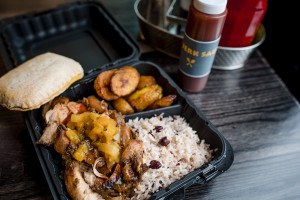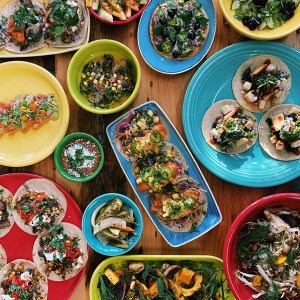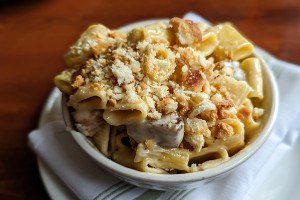What’s for Dinner…Next?
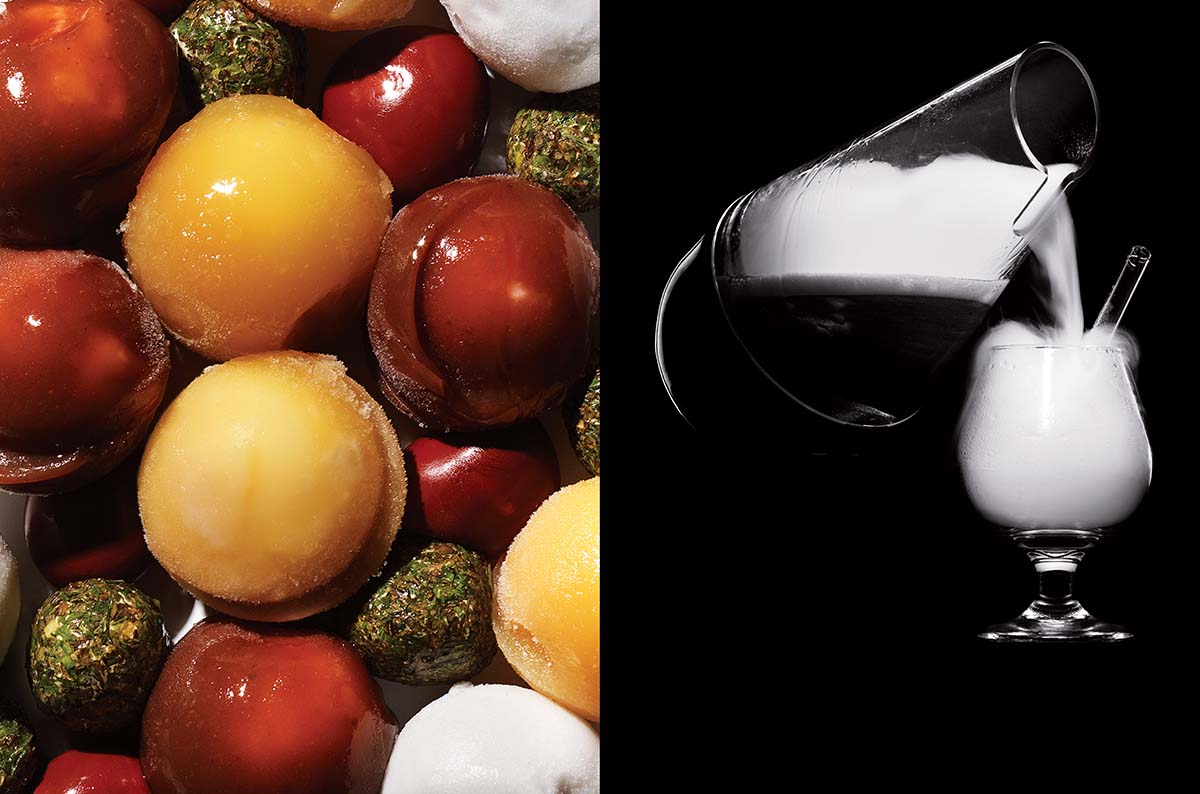
Harvard biomedical engineer David Edwards’s culinary innovations include WikiFoods (left), a line of bonbons enclosed in edible skins, and Le Whaf (right), which turns liquids into flavored vapor. PHOTOGRAPHS BY BRUCE PETERSON
On a quiet Paris street not far from the Louvre, behind a wrought-iron gate with the words “Le Laboratoire” artfully bent into it, sits the vast, glassed-in office belonging to David Edwards. It’s a stark, high-ceilinged room, with white industrial pillars and a black baby grand piano.
On a steel table, a carafe that looks a little like a lava lamp tipped on its side is softly bubbling. Curls of white vapor tumble out, filling the room with a sweet, chocolaty aroma. Gathered around it are three of the biggest players on the Boston dining scene: Todd Maul, Clio’s former bar manager; Tom Mastricola, who helped open No. 9 Park and was general manager of Clio and Commonwealth; and Patrick Campbell, formerly the chef de cuisine at No. 9 Park and executive chef at Eastern Standard.
They are about to inhale some chocolate cake.
Edwards invented Le Whaf, the device sending cocoa clouds into the air. Clad in a black velvet blazer and slim maroon pants, chin- length curls tamed behind his ears, he hands each of them a hard plastic straw, and instructs them to breathe in the vapor and “hold it in your mouth like a cigar.”
“I like the idea of a crazy chocolate dessert,” Maul says between drags.
Maul, Mastricola, and Campbell are here in Paris because of Edwards, a biomedical engineer with a very specific vision for the future of food. This fall, in Cambridge, Edwards will open the U.S. flagship of his Parisian think tank, Le Laboratoire. It will be a 13,000-square-foot space at 650 East Kendall Street, in the heart of the biotech community. At Le Laboratoire Cambridge, there will be lectures open to the public from poets, scientists, and visiting chefs. There will be cultural exhibitions from luminaries such as the MIT Media Lab’s Tod Machover, an innovative composer, and Neri Oxman, a 3D-printing and environmental-design specialist.
And there will be a restaurant, slated to open in September, run by Maul, Mastricola, and Campbell: Café ArtScience.
Picture a 120-seat space created by French designer extraordinaire Mathieu Lehanneur: wavy green banquettes, a giant honeycomb-shaped chandelier, and a podlike private dining room that converts into a whiteboard-walled lecture hall, where Edwards, a professor at Harvard, will teach his perennially popular engineering course, “How to Create Things & Have Them Matter.” Up front will be a 24-seat bar dubbed the “WikiBar,” across from an “innovation corner” where visitors can view and purchase Le Laboratoire’s latest inventions. Edwards envisions Café ArtScience as the entry point to his universe: a network of inter- national labs, educational programs, and cultural centers that embody the term “ArtScience,” his word for the specific place where aesthetic (“art”) and analytic (“science”) modes of thinking collide.
Until late last year, Café ArtScience was just going to be a place where you could try out Edwards’s product line, plus coffee from Parisian roasters Café Coutume, while padding your stomach with sandwiches and salads from a caterer. But then Edwards met Maul. At Clio, Maul already had a reputation for hacking cocktails with chemists’ tools. His Manhattan gets its mellow finish from port essence distilled in a rotary evaporator; the main ingredient in his burnt-cinnamon daiquiri is lime juice that’s been clarified by a spin through a centrifuge. Maul and Edwards clicked immediately: Edwards could bring Maul a whole new arsenal of ideas and tools, and Maul could bring culinary legitimacy to Edwards’s product line. The two formed a partnership, and brought on Mastricola as general manager and Campbell as chef.
A hybrid restaurant-lab is, in many ways, the perfect distillation of what’s happening right now in Kendall Square—a neighborhood built around innovation and already home to restaurants like West Bridge, Commonwealth, Catalyst, and Area Four. Edwards could have taken Le Laboratoire to New York or San Francisco, but he says he felt more at home here. And it helps that over the past several years, Cambridge has become an unlikely mecca for culinary thought leaders. In 2010, El Bulli’s Ferran Adrià cofounded the “Science and Cooking” lecture series at Harvard that has attracted chefs like Momofuku’s David Chang and Grant Achatz, of Chicago’s Alinea. Now those chefs routinely collaborate with MIT and Harvard microbiologists, architects, and researchers. Jesse Baerkahn, the lawyer who helped facilitate Kendall Square’s restaurant boom, says that combined, Le Laboratoire and Café ArtScience are “in a powerful and transparent way, claiming the connection between science and food innovation.”
Since most of Edwards’s inventions are not yet available stateside, he arranged a trip to Paris, where Maul, Mastricola, and Campbell could get to know his products: Le Whaf, which turns flavored liquids into vapor; AeroLife, ChapStick- size tubes containing huffable powdered supplements; and WikiFoods, a line of bonbons enclosed in edible skins. It’s crucial to Edwards that Mastricola, Maul, and Campbell be thrust into his world headfirst; if all goes well in Cambridge, there will likely be another Café ArtScience—in Paris. After that, who knows: There could be a Café ArtScience in Chicago. Or Miami. Or even Dubai.
When I first meet the Café ArtScience team in Paris, they’ve already been in town for four days, and have completed about half of the monster schedule Edwards planned out for them: dinner at Le Chateaubriand, Paris’s restaurant of the moment, to meet Edwards’s friend, the chef Inaki Aizpitarte. Lunch with a performance artist who will be designing some of the serving pieces for Café ArtScience. A meeting with the head bartender at Silencio, a Parisian club owned by David Lynch (yes, that David Lynch).
The plan tonight is to meet up with a man Campbell refers to only as “Dirty.” I later learn Dirty is Aaron Rosenthal, a 24-year-old former No. 9 Park intern (and Wayland native) working as a line cook at Septime, a trendy restaurant in Paris’s increasingly hip 11th Arrondissement; we’re meeting him at Le Repaire de Cartouche, a bistro famous for its charcuterie. Once we’ve piled into a dark corner table in the restaurant’s basement, Dirty glides in—forearms dotted with the small burn marks typical of a line cook, wearing a maroon T-shirt spreading the gospel “You Have a Friend in Cheeses” in yellow type. He orders quickly for us in French, and the table fills almost immediately with a mosaic of terrines and pâtés in every color, animal part, and permutation imaginable.
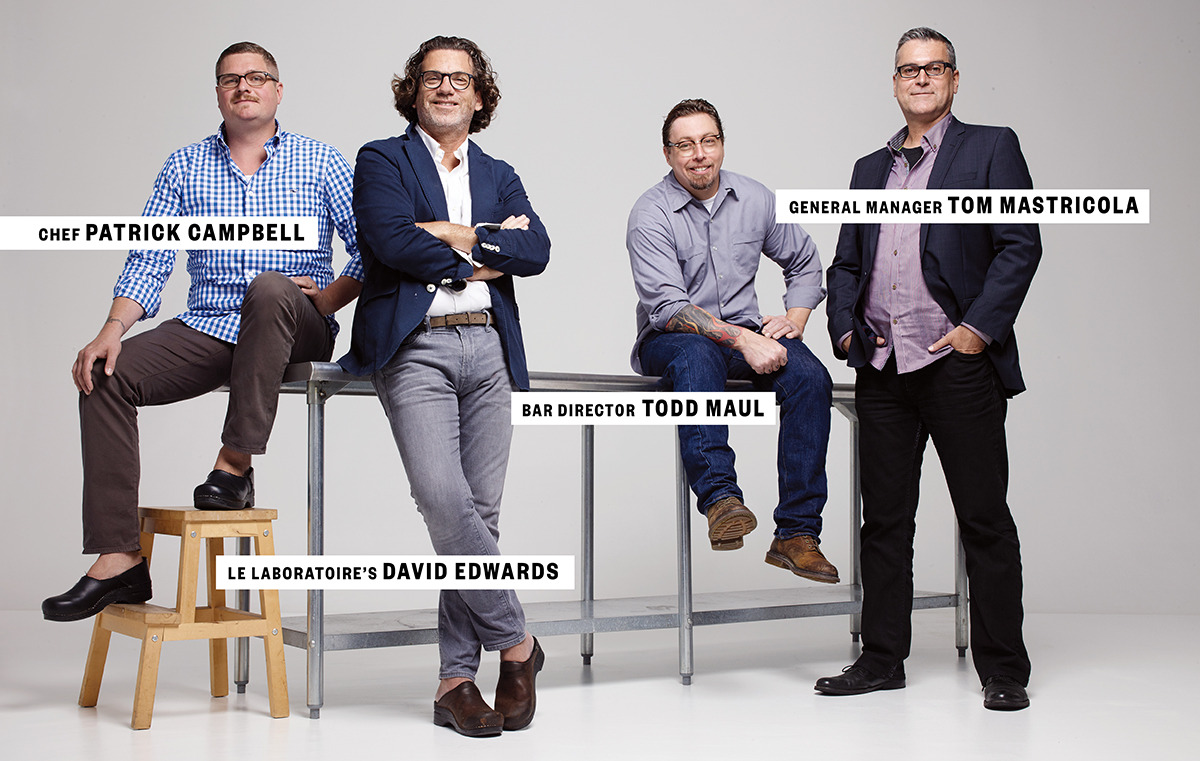
Photograph by Bruce Peterson
As our knives greedily dispatch the spreadable meats, Dirty asks for the scoop on Café ArtScience. “I’m excited to see what it will be!” he says.
“So are we,” Campbell replies. He launches into the spiel: The restaurant will offer Café Coutume’s coffee in the morning, served from the WikiBar. Then lunch service, designed to cater to the quick-in, quick-out biotech neighborhood: burgers and handcut fries, niçoise salads with olive-oil-poached tuna. By evening the bar will be Maul’s domain, the place where he’ll debut soon-to-be-patented ice cubes that alter cocktail flavors as they melt, plus other high-tech collaborations with Edwards. Then, at dinnertime, Campbell’s menu: dishes like peekytoe crab in gelée with apples, American caviar, and lobster oil, and Okinawa yam agnolotti with glazed pork belly, grilled cipollini onions, and fermented ginger.
Dirty is familiar with Edwards’s work. “Are you going to use the vaporizers?” he asks, smirking. “The spray scents?” He lets out a snort.
It’s a sentiment they’ve heard before. After learning about Edwards’s products, many assume that Café ArtScience, too, will be whimsical, even verging on gimmicky. “I always joke with [Mastricola]: Is it like Violet Beauregarde? Is it like Willy Wonka?” says Commonwealth chef-owner Nookie Postal, who recently worked with Mastricola. Others, like Ken Oringer, question how much science should find its way onto the plate. “It’s an intellectual city, but I think that people would rather debate about things in a boardroom or lab, and just eat food that they are kind of comfortable with,” says Oringer, who has worked with Maul and Mastricola at Clio (as well as with Café ArtScience’s executive sous chef, Chris Cordiero, and pastry chef, Renae Connolly, both former Clio pastry chefs). “Bostonians are practical people. They don’t want their food fussed with too much.”
And it won’t be, Campbell stresses. He was brought on precisely because he’s a steadfast traditionalist—the one tasked with balancing Edwards’s futurism with real culinary muscle. Eventually, Wikis and Whafs will make their way into his kitchen. But for now, the focus is on creating food that’s simply great. “Everyone is just kind of like, ‘Why are you involved?’” he said earlier. “I’m not doing clouds of anything, or having bacon floating through the air. That’s not what it is.”
As we talk in the dining room of Le Repaire de Cartouche, I notice Mastricola silently staring at the mirror behind my head, observing as servers orchestrate the evening through the reflection. As general manager of Café ArtScience, he’ll have to bring this watchfulness to make sure everyone stays on task.
“We have to be careful on this opening and everything that’s going on with the different things that we’re doing,” Mastricola told me earlier. “It’ll be somewhat of a performance, but it’s not just a performance. First and foremost it is a restaurant, and we can’t lose focus on that.”
Edwards lives with his wife, Aurélie, and their three sons in Paris’s tony Saint-Germain-des-Prés neighborhood. Their apartment, where we’ve been invited for an apéritif, is filled with light, with high ceilings and modern artwork. The coffee table is laden with snacks: cherry tomatoes, shelled peanuts, a dish of Apéricubes—dice-size blocks of processed cheese—and a platter of Pringles that have been unsheathed from their can and fashioned into a serpentine curve.
As he doles out the Apéricubes, Edwards explains that the foil-wrapped cheese inspired his “WikiFoods” line of Ping-Pong-ball-size orbs filled with cheese, soup, yogurt—anything that can be encapsulated within a patented edible skin called “MIPG” (short for “multi layered insoluble particle gel”). Why “Wiki”? The name refers to the “consumer-edited nature” of the product, Edwards explained later in an email. “People will ultimately design their food products like they create their meals, personalized and right for the moment…. One day you will have means of sale and distribution that will let you say, ‘Make this skin, this form, and this content and please give me five.’” Stonyfield Farm has licensed the technology for fruit-flavored frozen-yogurt WikiPearls that have begun popping up in Boston-area Whole Foods groceries. At the 2015 Cape Town Marathon, Edwards plans to debut WikiWater, which will have a biodegradable shell that can be peeled off, revealing a nutrient-infused MIPG skin and a water core—hydration for runners, sans packaging.
